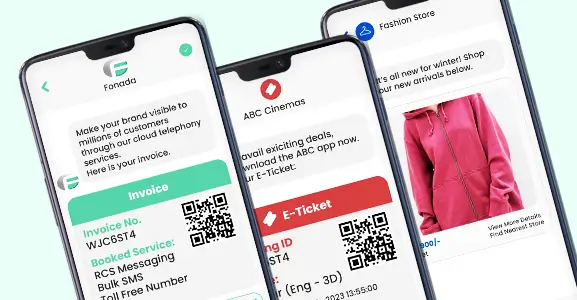VERIFICATION API SOLUTION
FOR BUSINESSES
Empower your verification process with smarter, safer, and budgeted solutions.

What Are Verification APIs?
Verification APIs are programming interfaces for applications that enable developers to integrate a verification service into their software applications. With the help of these APIs, businesses can automate their verification process for user data, such as email addresses, phone numbers, and identification documents, by connecting to third-party verification services.
Verification APIs help businesses and organizations to streamline their verification processes, reducing the need for manual verification and human intervention. These APIs can be used in various industries, including finance, healthcare, e-commerce, and social media. They are particularly useful for businesses that need to verify their users’ identity or authenticate user data’s accuracy.

Features Of OTP
Verification API Solutions
Stay Ahead Of Fraudsters With Our Advanced Verification Code API

Real-Time Verification
Helps businesses to fetch instant verification results to businesses, allowing them to make quick decisions and provide a better customer experience.

Security
The advanced encryption algorithm of API verification helps businesses ensure customer data security and privacy.

Customization
Businesses can customize the verification process to meet their specific needs and requirements.

Fraud Detection
With OTP verification API, businesses can detect and prevent fraud by flagging suspicious activity and identifying potential fraudulent behavior.

Identity Verification
Verification API enables businesses or organizations to verify the identity of their customers using a wide range of data sources, including government databases, credit bureaus, and social media platforms.

Why Integrate A Verification API Portal?
To improve the security of their web applications, businesses should incorporate a verification API service into their current application or CRM. Such a service should be capable of handling code delivered through various channels, such as



This will help to mitigate the risk of unauthorized access and protect sensitive user information from falling into the wrong hands.

How Fonada’s Verification API Works?
Stage 01
An application or website requests the verification API to initiate the verification process.
Stage 02
The verification API is designed to send a verification code to the user via a predecided channel such as SMS, email, or voice call.
Stage 03
Once the user enters the verification code back into the application or website.
Stage 04
The verification API compares the code given by the user with the one sent.
Stage 05
If the code is correct, the user can access the desired feature or service.
Stage 06
Verification API services follow advanced encryption and security protocols to protect user information and ensure data privacy.
Authentication Platforms For API Verification


Verify user authentication with one-time passwords (OTP) using SMS services. Approve sender identification compliance with rules and guidelines.


Send Text-to-speech (TTS) code to users with the help of a voice note. It acts as a backup for SMS verification API.


Authenticate the user workflow with WhatsApp inclusion. This platform enables businesses to reach clients via SMS or Voice service.
Fonada’s Verification API Service
Simplify Your Verification Process With Safer, Smarter & Cheaper Solutions!

Flash Call Verification
Once the user enters the verification code back into the application or website.

Data Verification
Get verified data instantly and enjoy proven security measures while enjoying a seamless user experience. Our services provide everything you need for a smooth and hassle-free verification process.

Phone Call Verification
Verify any user, anytime, anywhere, with our global call verification services. We offer verification for both mobile and landline numbers, ensuring comprehensive coverage for all your verification needs.

Use Cases Of Fonada’s API Verification Service

Benefits Of OTP Verification API
Power Up Your Verification Process with Verification API Solution

Improved Data Accuracy
With the help of OTP verification APIs, businesses can ensure the accuracy of user data, such as email addresses, phone numbers, and postal addresses. By verifying these information in real time, businesses can reduce the risk of errors and improve the quality of their customer data.

Fraud Prevention
Verify API prevents fraud by authenticating the authenticity of user information, such as identity documents or payment details. This can reduce the risk of fraudulent activity and protect the business and its customers.

Time And Cost Savings
Businesses can automate the user verification process with the help of API verification, which can save time and money compared to manual verification processes.

Compliance
Verification API enables businesses to comply with regulatory requirements, such as Know Your Customer (KYC) and Anti-Money Laundering (AML) regulations.
Why Choose Fonada For Verification API Solution
Power Up Your Verification Process with Verification API Solution

Proven Reliability
Fonada's verification API services have been extensively tested and are proven to be reliable and secure.

Multi-Channel Support
Get Multi-channel support, making it easy for users to receive verification codes through voice, text and mail.

Customization
Experience the highly customizable service, allowing you to tailor the verification process to your business needs.

Scalability
Fonada's Verification API solution is designed to handle large-scale verification requests, making it ideal for businesses of all sizes.

Competitive Pricing
Get competitive pricing and the best value for your money.

Dedicated Support
Our experts are available 24*7 to resolve all your queries and issues with the service.

Seamless Integration
Our verification API solution is easy to integrate with your existing applications or websites.

Latest Updates
From Fonada
Industry Insights, Trends, Innovations, Updates, and Case Studies from Industry Experts
View
Customer
Reviews
Discover why our customers love us - read their authentic and heartfelt reviews!
View
Frequently
Asked Questions
Get answers to common queries quickly with our informative Frequently Asked Questions section.
View
Convert Leads Into Sales With Fonada
Trusted CPaaS Solution Provider














